Page 257 of 417

256 OperationTires and wheelsDirection of rotation
Unidirectional tires offer added advan-
tages, such as better hydroplaning perfor-
mance. To benefit, however, you must
make sure the tires rotate in the direction
specified.
An arrow on the sidewall indicates the
intended direction of rotation (spinning) of
the tire.
Loading the vehicle
Two labels on your vehicle show how much
weight it may properly carry. �
The Tire and Loading Information
placard (Example A) or the Vehicle Tire
Information placard (Example B) can be
found on the driver's door B-pillar. This
placard tells you important information
about the number of people that can be
in the vehicle and the total weight that
can be carried in the vehicle. It also
contains information on the proper size
and recommended tire inflation
pressures for the original equipment
tires on your vehicle.
�
The Certification label, also found on
the driver’s door B-pillar tells you about
the gross weight capacity of your vehi-
cle, called the Gross Vehicle Weight
Rating (GVWR). The GVWR includes the
weight of the vehicle, all occupants,
fuel and cargo. The Certification label
also tells you about the front and rear
axle weight capacity, called the Gross
Axle Weight Rating (GAWR). The GAWR
is the total allowable weight that can be
carried by a single axle (front or rear).
Never exceed the GVWR or GAWR for
either the front axle or rear axle.
Warning
G
19" turbine-style wheels:
The wheels must be mounted corresponding
to the labelling on the inside of the rim,
where LEFT refers to the left-hand side of
the vehicle and RIGHT to the right-hand side
of the vehicle, both seen in direction of trav-
el. Otherwise the driving stability of the vehi-
cle will be adversely affected.
Page 278 of 417
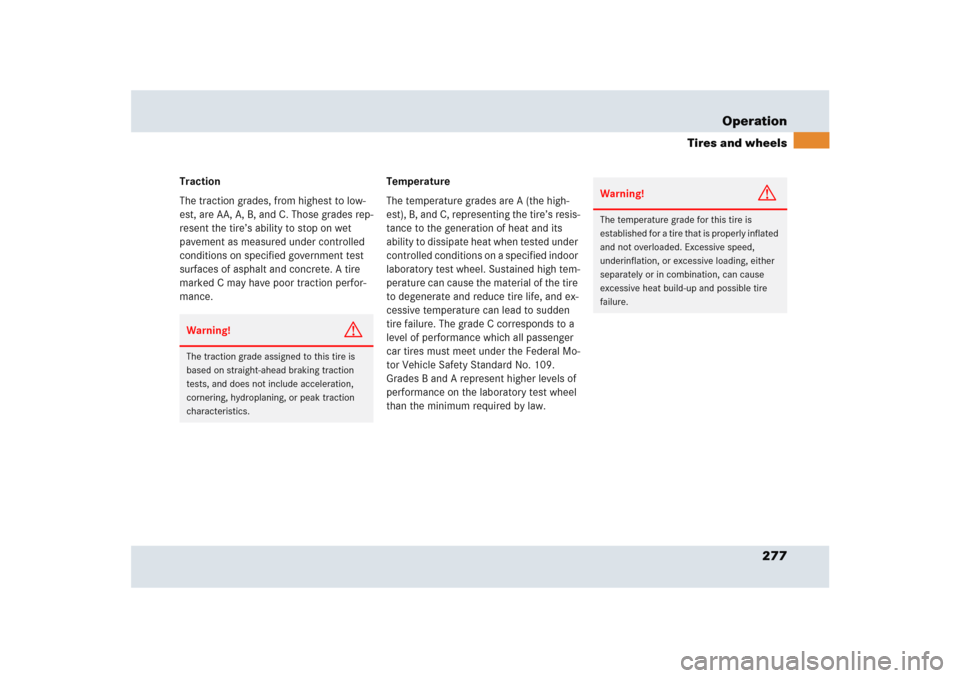
277 Operation
Tires and wheels
Traction
The traction grades, from highest to low-
est, are AA, A, B, and C. Those grades rep-
resent the tire’s ability to stop on wet
pavement as measured under controlled
conditions on specified government test
surfaces of asphalt and concrete. A tire
marked C may have poor traction perfor-
mance.Temperature
The temperature grades are A (the high-
est), B, and C, representing the tire’s resis-
tance to the generation of heat and its
ability to dissipate heat when tested under
controlled conditions on a specified indoor
laboratory test wheel. Sustained high tem-
perature can cause the material of the tire
to degenerate and reduce tire life, and ex-
cessive temperature can lead to sudden
tire failure. The grade C corresponds to a
level of performance which all passenger
car tires must meet under the Federal Mo-
tor Vehicle Safety Standard No. 109.
Grades B and A represent higher levels of
performance on the laboratory test wheel
than the minimum required by law.Warning!
G
The traction grade assigned to this tire is
based on straight-ahead braking traction
tests, and does not include acceleration,
cornering, hydroplaning, or peak traction
characteristics.
Warning!
G
The temperature grade for this tire is
established for a tire that is properly inflated
and not overloaded. Excessive speed,
underinflation, or excessive loading, either
separately or in combination, can cause
excessive heat build-up and possible tire
failure.
Page 285 of 417
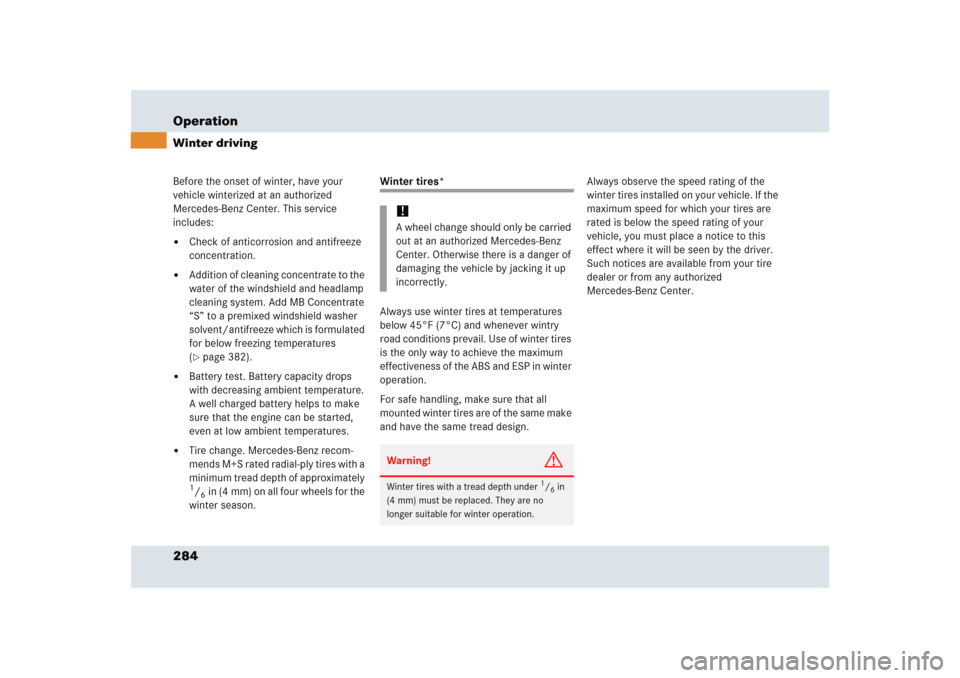
284 OperationWinter drivingBefore the onset of winter, have your
vehicle winterized at an authorized
Mercedes-Benz Center. This service
includes:�
Check of anticorrosion and antifreeze
concentration.
�
Addition of cleaning concentrate to the
water of the windshield and headlamp
cleaning system. Add MB Concentrate
“S” to a premixed windshield washer
solvent/antifreeze which is formulated
for below freezing temperatures
(�page 382).
�
Battery test. Battery capacity drops
with decreasing ambient temperature.
A well charged battery helps to make
sure that the engine can be started,
even at low ambient temperatures.
�
Tire change. Mercedes-Benz recom-
mends M+S rated radial-ply tires with a
minimum tread depth of approximately 1/6in (4 mm) on all four wheels for the
winter season.
Winter tires*
Always use winter tires at temperatures
below 45°F (7°C) and whenever wintry
road conditions prevail. Use of winter tires
is the only way to achieve the maximum
effectiveness of the ABS and ESP in winter
operation.
For safe handling, make sure that all
mounted winter tires are of the same make
and have the same tread design.Always observe the speed rating of the
winter tires installed on your vehicle. If the
maximum speed for which your tires are
rated is below the speed rating of your
vehicle, you must place a notice to this
effect where it will be seen by the driver.
Such notices are available from your tire
dealer or from any authorized
Mercedes-Benz Center.
!A wheel change should only be carried
out at an authorized Mercedes-Benz
Center. Otherwise there is a danger of
damaging the vehicle by jacking it up
incorrectly.Warning!
G
Winter tires with a tread depth under
1/6in
(4 mm) must be replaced. They are no
longer suitable for winter operation.
Page 286 of 417
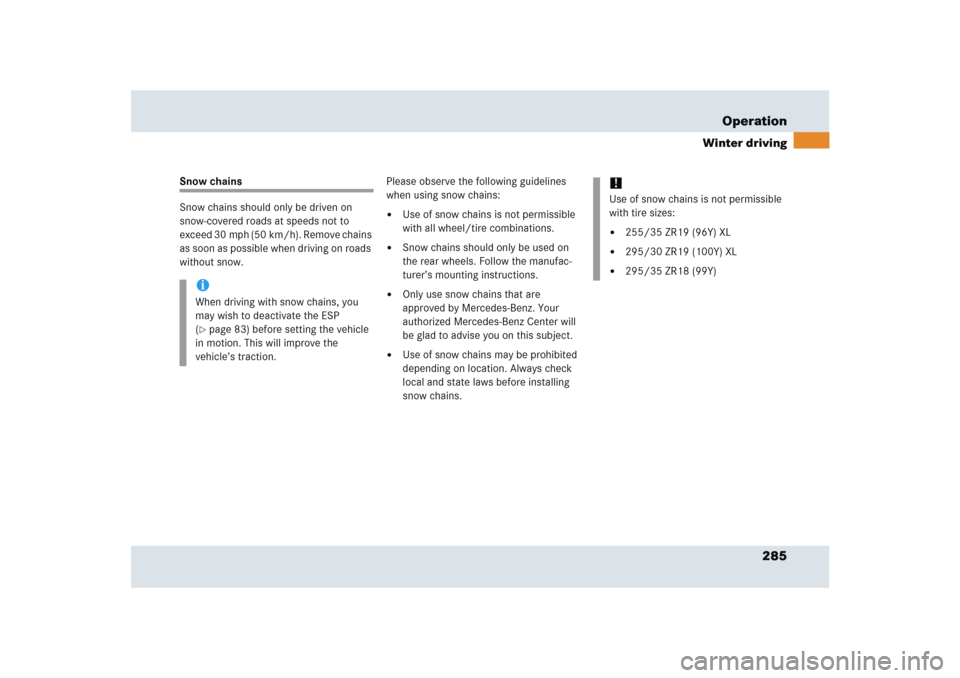
285 Operation
Winter driving
Snow chains
Snow chains should only be driven on
snow-covered roads at speeds not to
exceed 30 mph (50 km/h). Remove chains
as soon as possible when driving on roads
without snow.Please observe the following guidelines
when using snow chains:
�
Use of snow chains is not permissible
with all wheel/tire combinations.
�
Snow chains should only be used on
the rear wheels. Follow the manufac-
turer’s mounting instructions.
�
Only use snow chains that are
approved by Mercedes-Benz. Your
authorized Mercedes-Benz Center will
be glad to advise you on this subject.
�
Use of snow chains may be prohibited
depending on location. Always check
local and state laws before installing
snow chains.
iWhen driving with snow chains, you
may wish to deactivate the ESP
(�page 83) before setting the vehicle
in motion. This will improve the
vehicle’s traction.
!Use of snow chains is not permissible
with tire sizes:�
255/35 ZR19 (96Y) XL
�
295/30 ZR19 (100Y) XL
�
295/35 ZR18 (99Y)
Page 297 of 417
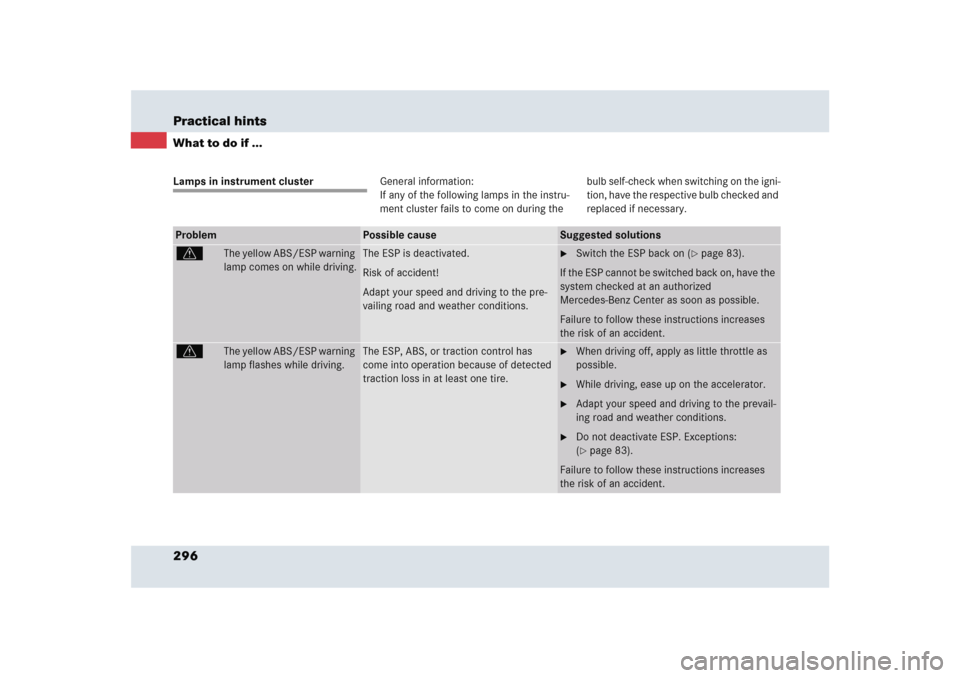
296 Practical hintsWhat to do if ...Lamps in instrument clusterGeneral information:
If any of the following lamps in the instru-
ment cluster fails to come on during the bulb self-check when switching on the igni-
tion, have the respective bulb checked and
replaced if necessary.Problem
Possible cause
Suggested solutions
v
The yellow ABS/ESP warning
lamp comes on while driving.
The ESP is deactivated.
Risk of accident!
Adapt your speed and driving to the pre-
vailing road and weather conditions.
�
Switch the ESP back on (
�page 83).
If the ESP cannot be switched back on, have the
system checked at an authorized
Mercedes-Benz Center as soon as possible.
Failure to follow these instructions increases
the risk of an accident.
v
The yellow ABS/ESP warning
lamp flashes while driving.
The ESP, ABS, or traction control has
come into operation because of detected
traction loss in at least one tire.
�
When driving off, apply as little throttle as
possible.
�
While driving, ease up on the accelerator.
�
Adapt your speed and driving to the prevail-
ing road and weather conditions.
�
Do not deactivate ESP. Exceptions:
(�page 83).
Failure to follow these instructions increases
the risk of an accident.
Page 298 of 417
297 Practical hints
What to do if ...
Problem
Possible cause
Suggested solutions
-
The yellow ABS indicator
lamp comes on while driving.
The ABS has detected a malfunction and
has switched off. The BAS and the ESP are
also switched off (see messages in dis-
play).
The SBC brake system is still functioning
normally but without ABS available.
If the ABS control unit is malfunctioning
the automatic transmission may also be
malfunctioning.
�
Continue driving with added caution. Wheels
may lock during hard braking, reducing
steering capability.
�
Read and observe messages in the display
(�page 304).
�
Have the system checked at an authorized
Mercedes-Benz Center immediately.
Failure to follow these instructions increases
the risk of an accident.
The charging voltage has fallen below
10 volts and the ABS was switched off.
When the voltage is above this value again, the
ABS is operational again.�
If necessary, have the generator and battery
checked.
Page 307 of 417
306 Practical hintsWhat to do if ...Text messagesLeft display
Right display
Possible cause
Possible solution
ABS
malfunction!
Visit
workshop!
The ABS has detected a mal-
function and has switched off.
The ESP and the BAS are also
deactivated.
The SBC brake system is still
functioning normally but with-
out the ABS available.
�
Continue driving with added caution.
Wheels may lock during hard braking, reducing steering
capability.
�
Have the system checked at an authorized
Mercedes-Benz Center immediately.
Failure to follow these instructions increases the risk of an
accident.
Display malfunc-
tion
Visit
workshop!
The ABS or the ABS display is
malfunctioning.
�
Continue driving with added caution.
Wheels may lock during hard braking, reducing steering
capability.
�
Have the system checked at an authorized
Mercedes-Benz Center immediately.
Failure to follow these instructions increases the risk of an
accident.
Page 308 of 417
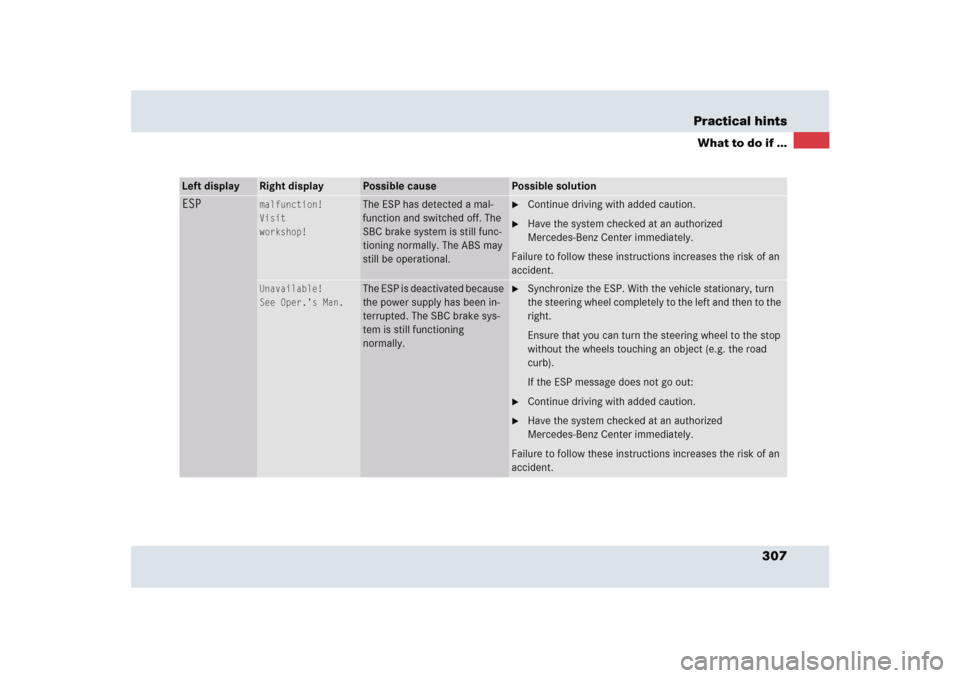
307 Practical hints
What to do if ...
Left display
Right display
Possible cause
Possible solution
ESP
malfunction!
Visit
workshop!
The ESP has detected a mal-
function and switched off. The
SBC brake system is still func-
tioning normally. The ABS may
still be operational.
�
Continue driving with added caution.
�
Have the system checked at an authorized
Mercedes-Benz Center immediately.
Failure to follow these instructions increases the risk of an
accident.
Unavailable!
See Oper.'s Man.
The ESP is deactivated because
the power supply has been in-
terrupted. The SBC brake sys-
tem is still functioning
normally.
�
Synchronize the ESP. With the vehicle stationary, turn
the steering wheel completely to the left and then to the
right.
Ensure that you can turn the steering wheel to the stop
without the wheels touching an object (e.g. the road
curb).
If the ESP message does not go out:
�
Continue driving with added caution.
�
Have the system checked at an authorized
Mercedes-Benz Center immediately.
Failure to follow these instructions increases the risk of an
accident.